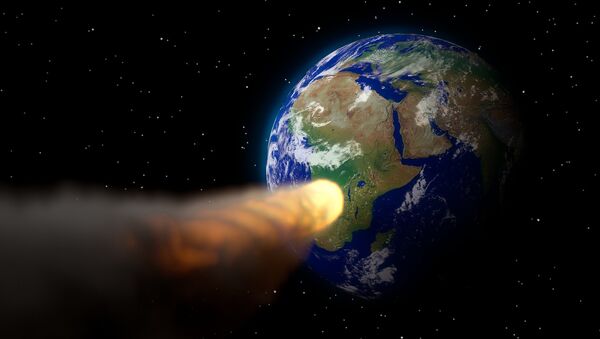Space may seem deathly still from Earth's surface, but the cosmos is anything but static — on top of space junk left by human exploration, which could well multiply exponentially in years to come, asteroids pulverize their rocky way through the heavens with much frequency, often perilously close to the Earth.
April 20's asteroid, 2014-JO25, is a leviathan measuring a kilometer across, and set to race past the planet closer than any asteroid of its size has in 13 years — although it will be at a relatively safe lunar distance of 4.6, or 1.8 million kilometers, away. The robotic telescope service Slooh will screen a live fly-by.
From April 18-20, you can look for Asteroid #2014JO25 with a small telescope! Here's how to see it: @SkyandTelescope https://t.co/i9pcq62J6h pic.twitter.com/dCnqSFAS72
— Public Observatory (@SIObservatory) April 16, 2017
Still, if an asteroid that size did hit Earth, it would be catastrophic. If it crashed into the sea, it would produce tsunamis capable of wiping out coastal cities. If it hit land, the results would be comparable to 10,000 megatons of TNT striking the Earth.
Kilometer-wide asteroids are in any event not what keep astronomers awake at night — after all, such a big slab of solidity heading Earth's way is very easy to spot, from very far away. If and when detected on the far horizon, mankind would theoretically have years to respond.
Arecibo radar also got an interesting view of twin-lobed contact binary asteroid #2014JO25 on April 17: https://t.co/L4x9xLimlD pic.twitter.com/uiuMYSQBCn
— Dave Dickinson (@Astroguyz) April 19, 2017
Something much smaller and imperceptible, such as the object that exploded over Chelyabinsk in Russia in 2014, is a much greater danger. Despite being only 10-20 meters in width, it caused significant damage to the area.
Nonetheless, many scientists are concerned about the prospect of a major object hitting the Earth at some stage — such crashes may not be common in Earth's four and a half billion year history, but the law of averages, and fate, mean humans should probably be on guard.
If a kilometer-sized asteroid did hit, the impact would be comparable to half a million of the atom bombs that obliterated Hiroshima in 1945.
Asteroid 2014 JO25 will safely pass Earth tomorrow. We viewed it w/ radar data today, from 1.9 million miles away. https://t.co/FPICdrj26M pic.twitter.com/5CyL35W7gz
— Asteroid Watch (@AsteroidWatch) April 19, 2017
NASA tracks asteroids as part of its Near Earth Object program.
The asteroid that currently poses the greatest threat to Earth is 29075, which is 1.3 kilometres long. NASA estimates it will near Earth March 16, 2880, although the probability of impact is one in 8300, meaning a 99.988 percent likelihood of it missing the Earth.
Earth's defenses against asteroids (or lack thereof) have been high on the news agenda ever since NASA senior scientist Joseph Nuth warned in December 2016, Earth was due a "dinosaur-killer" comet any moment.
If that came to pass, Nuth said, "there's not a hell of a lot we can do about it," — even if all world governments, space agencies and private space companies were given abundant notice of a coming strike, it would take at least five years to create and launch a deflective spacecraft, he suggested.
His caution soon proved to be almost eerily prophetic, given the Earth proceeded to narrowly avoid being hit by a volley of asteroids.
In January 2017 alone, there were numerous near-misses; AG13 barely missed, three separate asteroids almost hit in the space of a week, and BS32 raced past the planet just days after discovery.

